How to eat a bagel like a New Yorker: A bagel manifesto
“How to eat a bagel like a New Yorker: A Bagel Manifesto.” The history of the bagel and where and how to eat a bagel like a New Yorker. It’s harder than it seems!
What is a bagel?
A bagel is an iconic New York food. It’s a round bread, with a hole in the middle, savory, crunchy on the outside and chewy on the inside. It’s topped with seasonings and traditionally filled with cream cheese and smoked fish. It’s most known as a breakfast item but can be eaten at brunch or lunch time. It’s Eastern European Jewish in origin but has become to New York what the croissant is to Paris, the churro to Madrid or the alfajor to Buenos Aires. These days you can eat a bagel almost everywhere, but New York is the mecca of the bagel (and to not pick a fight, Montreal doesn’t make a bad bagel either).
This article explains the history of the bagel and is a guide to how to find, order, and eat a bagel the New York way. If you just want a recommendation of top New York bagels, scroll to the bottom.
We think that bagels are an essential part of New York life. So much so that we decided our first blog post should be about bagels. Likewise, my wife Mercedes (@vegmer) drew three postcards of New York icons. One of them is, of course, a bagel:
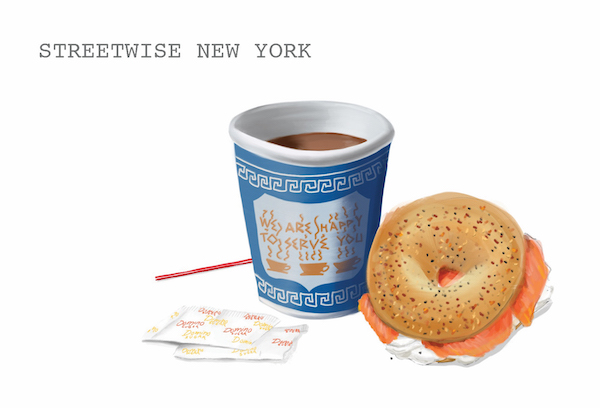
A postcard illustrated by Mercedes Vega Villar(@vegmer)
A Bagel History
Eastern European Roots
What makes bagels special is that they are a boiled bread. Bagels were first documented in 17th Century Krakow, Poland. Legend has it that the King of Poland forbade Jews to bake bread. If you can’t bake, you can still boil! Jews responded to the hate, with a shrug of the shoulders and invented the bagel. That’s how we roll! Over time bagels spread throughout Eastern European Jewish communities and were brought to New York by the over 2 million Jewish immigrants who came at the end of the 19th and early 20th century. Bagels are still made here today. Although they are still boiled, we bake it at the end to give a crunchy exterior. Don’t tell the King of Poland!
A New York Bagel Rennaiscance
Bagels after WWII disappeared from Eastern Europe but thrived in New York. At first, they were sold only within Jewish communities like the Lower East Side from pushcarts but eventually, bagel stores were established across the city. By the second half of the 20th century, non-Jewish New Yorkers would become bagel mavens (Yiddish for experts). Today some of New York’s top bagel rollers are Thai immigrants!
Still, for a long time, bagels remained an exclusively New York treat. My father recalls that in the 1960s when his uncle Oscar moved to Chicago for work, he was shocked and upset that he could not find a bagel in the Windy City. Eventually, in the 1970s, bagels became popular across the country and in recent years across the world.
The Americanization of the Bagel
Today, you can find bagels everywhere but ask any New Yorker, it’s almost impossible to find a decent bagel outside of New York.
Unfortunately, outside of New York, bagels were treated like any ordinary piece of bread that can be filled and flavored as one pleases. They ceased to be a food grounded in the Jewish community shaped by tradition and religion. They became Americanized, super-sized, mass-produced in multitudes of new flavors with infinite fillings and gimmicky spin-offs like “pizza bagels”. Yes, Chicago and Nairobi now have bagels, but the bacon egg and cheese on a McDonald’s “bagel” would be unrecognizable to my poor great uncle Oscar.
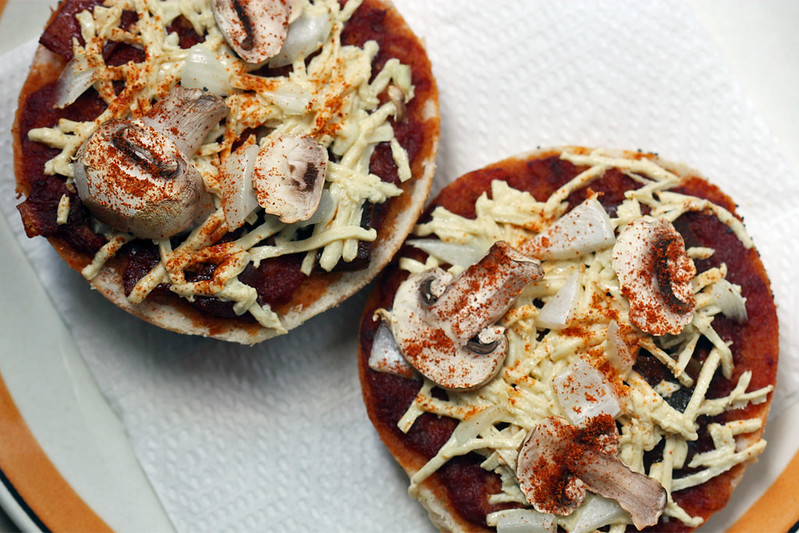
Pizza Bagel. A bagel No-No
In the last 20 years, these bagel crimes have made their way back to New York. New York bagel store owners, forced by competition and the demands of non-New York transplants, sell varieties of bagels and toppings that even they will admit are sacrilegious.
Bagel purists in New York routinely express outrage on Twitter about even the smallest deviations in bagel tradition. New York Mayor De Blasio, Boston born and raised, was lambasted for tweeting out his toasted bagel order. Real New Yorkers don’t toast their bagels!
As a life long New Yorker, I want to show you where to eat a bagel and how to eat a bagel like a New Yorker. You’ll have the most authentic New York experience and won’t be judged by those around you.
Mayor de Blasio deleted a tweet in which he described his favorite bagel as "toasted" #bagelgate 🔥🥯 pic.twitter.com/QfbFMOxXRU
— Anna Sanders (@AnnaESanders) January 15, 2020
How to order a bagel
1. What type of bagel you want?
2. Toasted or untoasted?
3. What filling do you want in the bagel?
4. Get out the way!
View this post on Instagram
What type of bagel should I order?
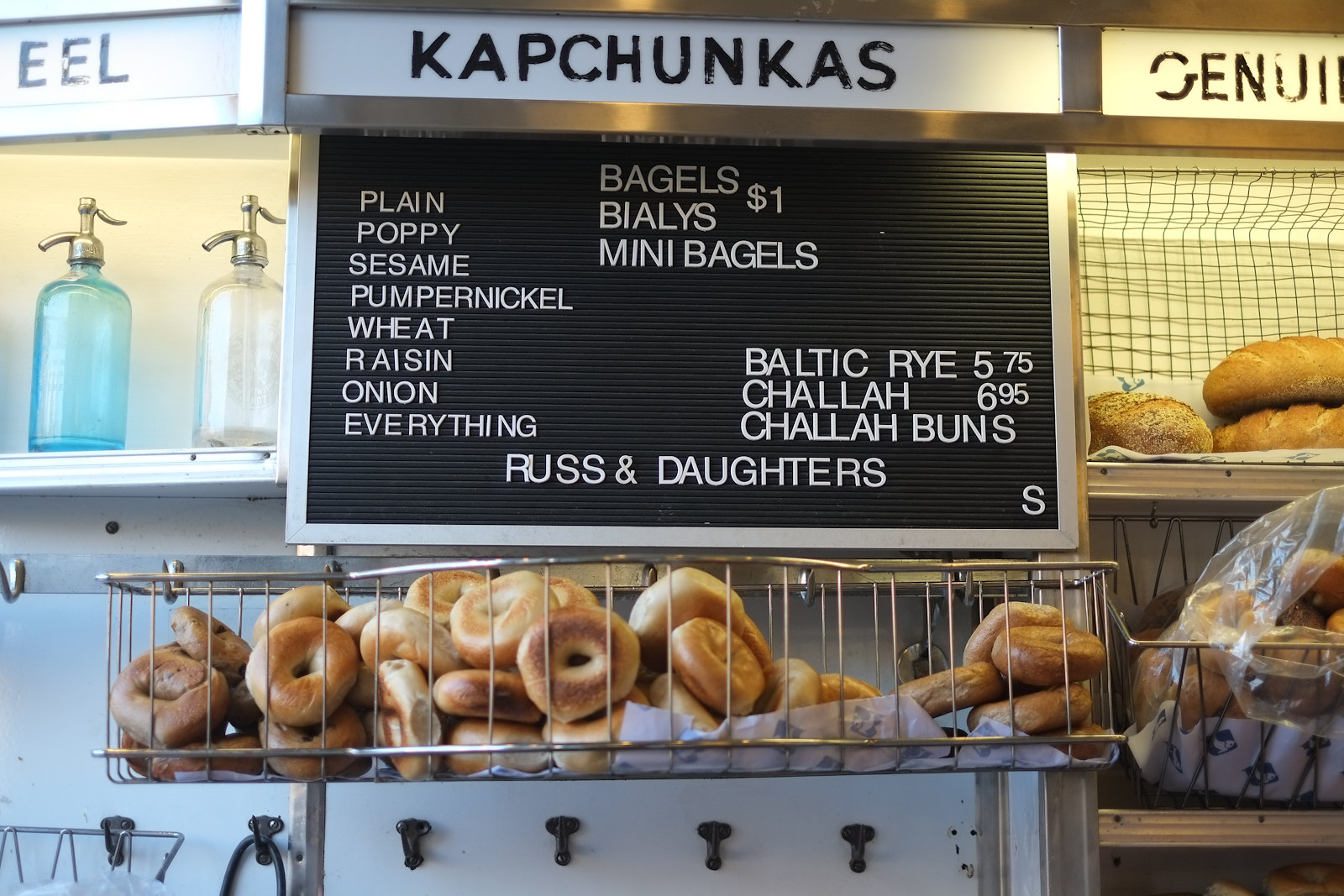
Bagel Choices at Russ and Daughters
- Onion
- Garlic
- Poppy Seed
- Sesame
- Salt
- No toppings (“plain”)
There are some modern innovations that you can also consider:
- Gluten-free: For celiacs. In the Jewish religion, health comes even before religious obligation!
- Cinnamon raisin: Not an original but it’s become the only non-savory accepted flavor in the past 50 years. We’re partial to dried fruit.
- The everything bagel: A creation in the past 20 years. It combines all the original toppings. It’s my go-to choice. It embellishes but doesn’t deviate from tradition. It’s so popular they sell “Everything but the bagel seasoning”
But avoid modern innovations like sun dried tomato or blueberry bagels!

An unfortunate bagel fad.
To toast or not to toast
New Yorkers are in agreement: if a bagel is well made and fresh, you should never toast it. It would be like taking a perfectly cooked steak and throwing it back on the fire. A fresh bagel in New York City means it has been made in the past 5 hours.
If it’s not fresh or it’s a bad bagel, like in your hotel’s continental breakfast or your office meeting, then go ahead, toast it and hold your nose.
What should I put in my bagel?
The average bagel store menu will absolutely overwhelm a novice as to what to put in your bagel. They may have dozens of cream cheeses and a panoply of fillings. The fast-food “Have it Your Way” mentality. But I’ll narrow down your choices for an authentic New York bagel experience.
First, bagels are Jewish and in the Jewish religion there are strict dietary laws. Food preparation must be Kosher. This means you can’t eat pork, shellfish or mix dairy and meat. So according to Jewish law, meals and restaurants must be meat or dairy. Establishments that sell bagels are traditionally dairy. Which means you can discard all the pork and meat options thrown at you.
The second thing is that bagels are traditionally eaten cold. It’s advantageous for Jewish people since on the Sabbath, Friday sunset to Saturday Sunset, religious Jews cannot cook. That means you can discard any option that is heated up: no fried eggs!
So what does that leave us? Butter, cream cheese, smoked fish and garnishes. These are things you’d traditionally find in an appetizing Store. I’ll break down each option:
Butter
A buttered bagel with nothing else on it is a common basic option. But you can do better than that!
Cream cheese
The most popular choice. The most famous brand of cream cheese is Philadelphia but a quality bagel shop will have natural locally made cream cheese. It makes a difference. The common phrase you’ll hear in a bagel shop is “with a schmear.” Schmear is Yiddish for spread. The server will understand that you want plain cream cheese and not too much. Otherwise the default is to give you the Americanized super-sized portion of cream cheese. Yuck!
If you’re lactose intolerant, Go for tofu cream cheese.
For flavored cream cheese, scallion is common and I’ll look the other way if you order vegetable cream cheese. But please remember every time someone orders jalapeño-bacon cream cheese a Rabbi somewhere cries.
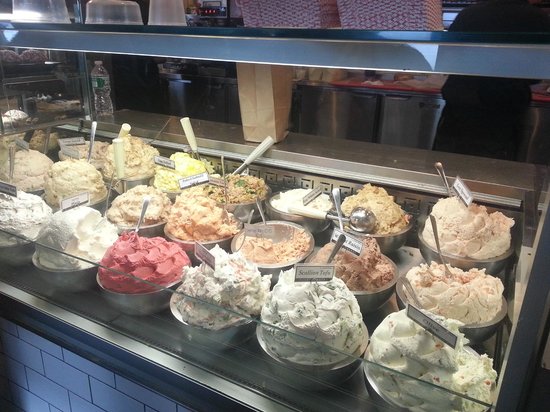
Way too many cream cheese options!
Smoked or Cured Fish (Lox)
The most common option is Nova Scotia Lox. It is a cured and cold-smoked salmon. The word “lox” comes from a Yiddish word for salmon. Lox for Jews is like cured ham for Spaniards or caviar for Russians. It is a highly valued delicacy. There are many types and levels of quality. Also, cutting lox properly is a highly skilled profession.
At the best places to eat lox in New York like Russ and Daughters, the top lox costs $55 a pound or $121 a kilo. But there are plenty of more affordable options.
Nova Scotia Lox is the most common option and it is the default. The are many other types of lox, cured and smoked differently plus smoked herrings and sturgeon. That’s for my bagel master class! For now let’s stick to the basics.
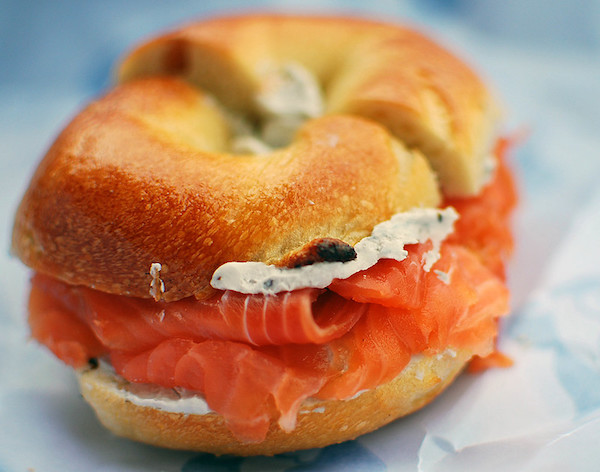
A bagel with lox and a schmear of cream cheese is the most common option.
Besides lox, it is very common to have:
- Tuna fish or egg salad. Eggs or tuna mixed with mayonnaise, celery, onion or garlic and seasonings.
- Whitefish salad. Whitefish is a mix of smoked whitefish, whiting, and mayonnaise. It is the fancier and superior cousin of tuna fish salad
Garnishes
Simple add-ons in order of popularity: tomatoes, red onions, and capers. Nothing else is allowed. No avocado toasts!
Get Out The Way
New York is fast-paced. The etiquette is that you do not get to the counter before you’re ready to order. If you’re deciding what you want to order while there is a line behind you, it is considered rude! In other parts of the United States, it is expected to exchange pleasantries with the server. In New York, greeting your server, asking them how they are, or complimenting them on their nails is frowned upon. It may give us the reputation of being unfriendly and overly direct but it’s the correct etiquette. Slowing things down and making people wait on line is the biggest social faux pas in New York society. So seriously, get out the way!
Where are the best bagels in New York?
Just like your bagel filling options, New York is set up so that you make the wrong choices. They sell bagels almost anywhere in New York. Countless coffee carts, supermarkets, diners, and delis sell bad bagels. Beware!
You should only get your bagel at a place that specializes in bagels and nothing else. Preferably, they should hand roll the bagels. The only exception to this rule is a café or restaurant advertising that they source their bagels from a known bagel store. And even in that case, the bagels are less likely to be fresh.
There are some places that are standouts in New York. Everyone who comes to New York should eat a bagel, but even a bagel enthusiast like myself wouldn’t suggest taking an hour subway ride for a ringed bread. So here’s is an incomplete list of good bagel places in areas where travelers to New York will most likely be.
If you like long subway rides, I’d be happy to share with you my spots in Bayside, Bay Ridge and Riverdale:
No Frills Classics
(Plain Bagel: $1-1.50; Bagel with Cream Cheese: $3-$4:50; Bagel with Lox and Cream Cheese: $9-$14)
- Russ & Daughters Appetizing Store: 179 East Houston Street A New York classic since 1914. No seating. A bit more expensive than the other options.
- Russ & Daughters To Go at Jewish Museum: 1109 5th Avenue at 92nd Street. Different menu than sit-down restaurant at same location.
- Ess-a-Bagel. 1st and 21st; 33rd between 6th and 7th Avenue; and 3rd Avenue and 50th Street (the 3rd Ave location is the most popular and may have lines (they have a back counter with shorter lines that will sell bagels, packets of cream cheese and smoked fish to go. You can then make your own bagel!;
- Zaros. On the list mostly because it is very convenient. More known for its jewish baked goods than bagels. Locations in Grand Central, Penn Station, 1825 Park Avenue (125th Street) and 501 7th Avenue (37th Street)
- Murray’s Bagels: (500 7th Avenue at 12th Street)
- Kossars Bialys: Classic place also know for Bialys, a baked cousin of the bagel (367 Grand Street)
- Black Seed Bagels: Hudson Eats (Brookfield Place in Financial District), Rockefeller Center (30 Rockefeller Center Concourse), Chelsea Market (9th avenue and 15th Street), 176 1st Avenue (at 10th Street), 1188 Broadway (28th Street)
- Shelsky’s of Brooklyn: A modern twist on the traditional. 141 Court Street (Brooklyn), and 453 4th Avenue
Fancy Schmancy Places
(Bagel with Lox and Cream Cheese: $15-$25)
Russ and Daughters Cafe: 129 Orchard Street: Café with bagel options, more elaborate dishes, and a full bar.
Jewish Museum (1109 5th Avenue at 92nd Street) Inside the museum (no need to pay admission) Sitdown restaurant, you can order to go as well. The museum and gift shop are both very nice.
Barney Greengrass: (541 Amsterdam Avenue at 86th Street) Since 1908, classic bagel menu. It is also known for sturgeon and eggs with lox.
Bonus: Insider’s Tip
Most places in New York that have lox or other Jewish smoked fish products buy them from Acme Fish Company. Acme has been running their smokehouse in Greenpoint, Brooklyn since 1906.
Every Friday, Acme hosts “Fish Friday.” From 8am – 1pm, they open their warehouse to the public and sell their smoked fish products at less than half the price than in supermarkets. I’m a big fan because I like deals, smoked fish and unexpected social interactions. Fish Friday attracts a very New York mix of people. While you wait in line for 20 to 30 minutes, you’ll mingle with many Jews, especially Hasidic Jews stocking up for Shabbat, Japanese families who appreciate high quality raw fish, Poles buying whole smoked fish and hipsters who heard about it from some blogger (like you!).
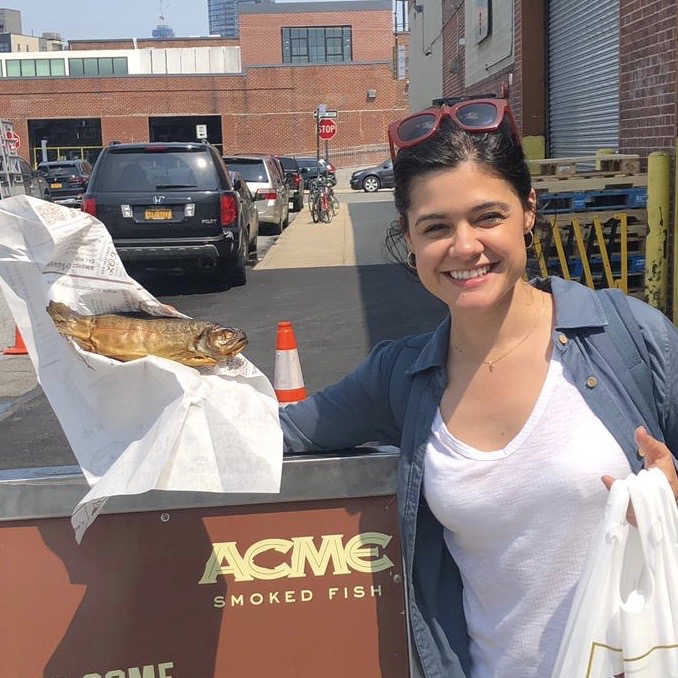
Also, Fish Friday is a rare opportunity to break with bagel tradition. Something I normally forbid you to do. Gary Brownstein, who’s been at Acme since 1967, offers up Gary’s specials, new unique smoked salmon creations each week. They may include ingredients like sriracha, bourbon, mango and maple syrup.
I know I’m resistant to modernization of bagel culture, but if anybody can usher bagels into the 21st Century, it’s Acme and Gary. Gary is a third generation Acme man. And besides, everything he makes is kosher!
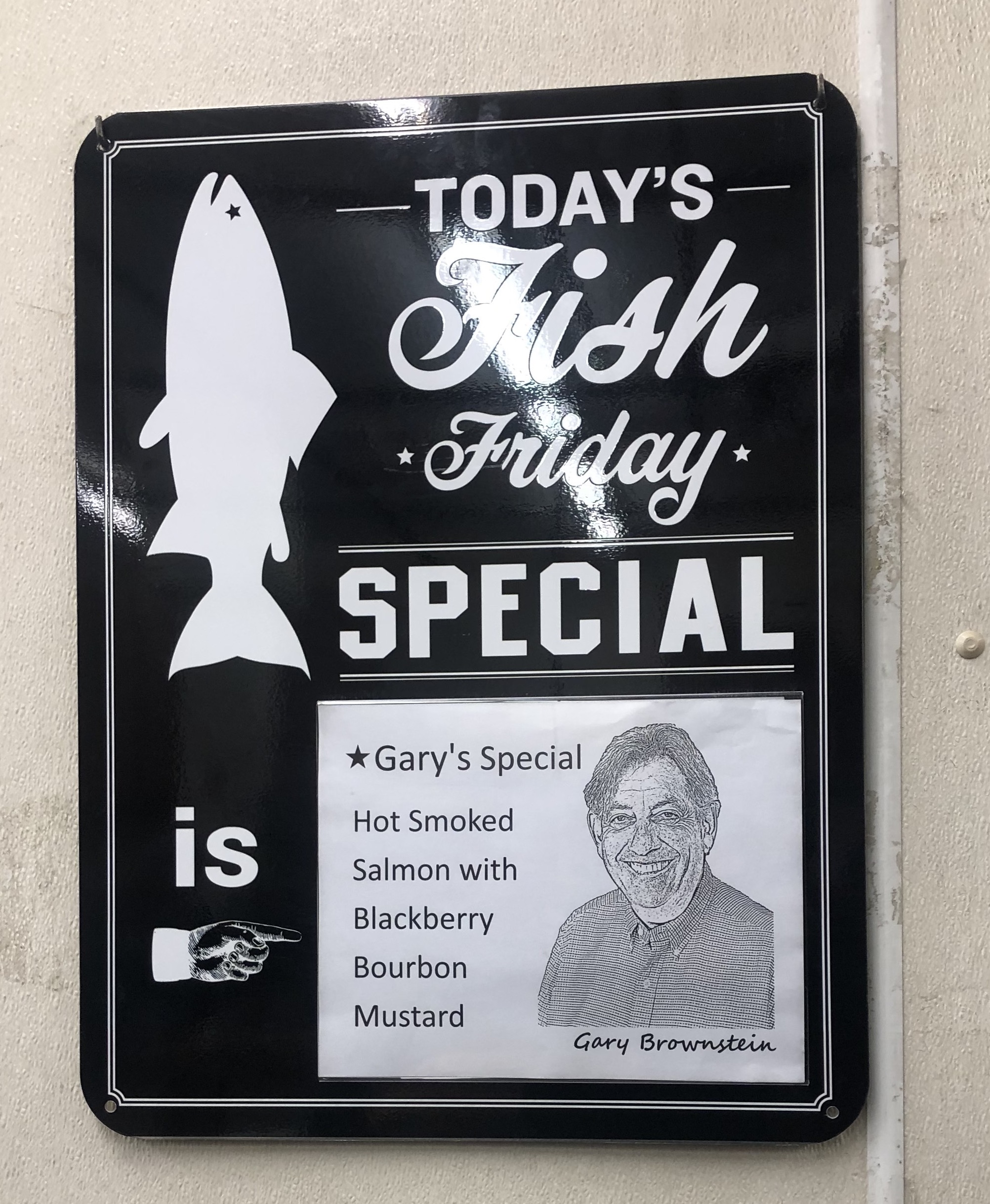
Because of Covid-19, I was not able to take all my own photos. Thanks to Jennifer Burk on unsplash and Flickr users.
